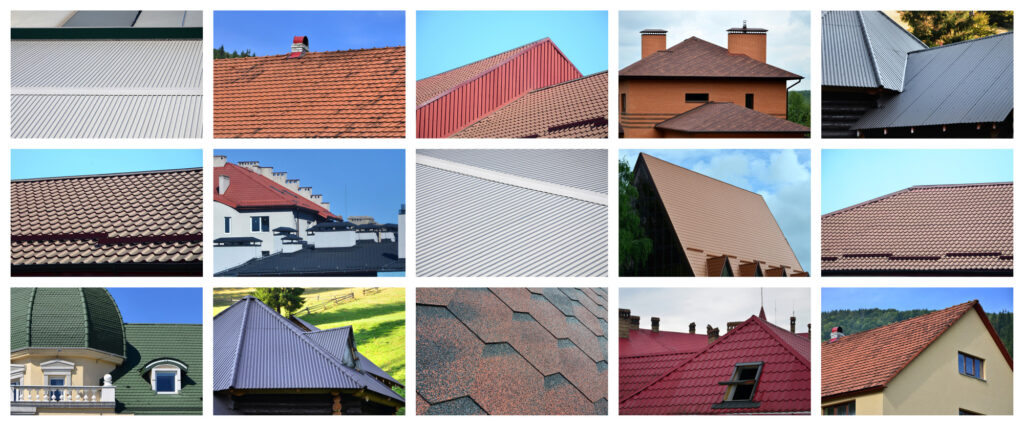
Top 5 Roofing Material Types for Replacement or New Installation
Are you ready to replace your roof but wondering where to start? Reroofing your home is considered one of the most significant upgrades you can do to a home. Not only will this increase protection against the elements, but it will also substantially increase the value of your home.
But, an increase in value comes with a price depending on the roofing material types you choose for your project.
If you need some insight into which type of roof works best, keep reading. In this article, we are giving you everything you need to know about the five best roofing material types that could work best for you.
Roofing Material Types
The type of material you choose for your roofing project depends on your budget, location preferred style. Some material types are suitable for dry climates, while some are better for harsher conditions. Let’s go over the advantages and disadvantages of each type.
1. Asphalt Shingle Roof
Asphalt shingles are the most common type of roofing material used today. Over 80 percent of all homes are fitted with asphalt shingles. Asphalt shingles are made of composite materials such as fiberglass cut up into tiny pieces.
The great thing about asphalt shingles is that they go great with any style of home. Whether you want a colonial style or rustic look, asphalt will do the job.
Advantages
Asphalt shingles are the most economical, costing right around $35 per bundle. They come in a wide variety of styles are amongst the easiest to install, and all you’ll need is a nail gun to install.
Disadvantages
Cheaper materials come with a price. One of the most significant drawbacks to asphalt shingles is they don’t provide any insulation to keep your home comfortable, and they don’t have a long lifespan compared to other roof materials.
2. Metal Roof
Metal roofs are made of aluminum, copper, zinc, or stainless steel. You’ll need more equipment to install a metal roof, which means installation requires more labor.
They are lightweight, sleek, and can be helpful in a variety of situations, such as harsh conditions. Metal roofs work well with cabins, sheds, and contemporary-style homes.
Advantages
Metal roofs, when cared for, can last a lifetime. Compared to the other roofing materials, they protect the best and can hold up against harsh winter conditions, such as slow sleet, hail, high winds, or rain. They also reflect harsh solar rays, keeping your home cooler in the summer.
Disadvantages
Metal roofing components can be expensive due to cost and labor prices. Sheets per roofing square can be between $100-300. When rain hits your roof, it can cause quite a lot of noise.
3. Wooden Roof
Wooden roof shingles have been the standard choice for hundreds of years for homes. They create a rustic look that is appealing to specific buyers. If you’re going for a cottage, bungalow, or Tudor-style home, installing a wooden roof is the way to go.
Advantages
They present an attractive natural look. They can come in many different colors depending on which wood you’re using.
Disadvantages
Wood roofs can be more prone to damage from the weather. They can grow mold more easily and some cities prohibit the use of wooden roofs due to fire codes.
4. Clay and Concrete Roof
Clay and concrete roof tiles add a scalloped and ribbed look to your house, providing style and flair. The intricate design of a clay roof can be complicated to install, so make sure that it’s done by a professional roofer if you do install it.
If you’re looking for a southwestern, Mediterranean, or Spanish-style home, installing clay roof tiles is a good option for a roof replacement. Learn more about various roofing options.
Advantages
One of the main advantages of a clay and concrete roof is that it gives off a sense of luxury and class. Many high-end homes found in upper-class neighborhoods feature clay roof tiles.
Clay roof tiles are non-combustible, durable, and long-lasting. They’re well insulated, which makes them energy efficient.
Disadvantages
One of the drawbacks of clay roof tiles is that installation and materials costs can be expensive. Also, they may require extra framing to install, and they’re very heavy to haul.
5. Slate Roof
Slate roofs give off a distinctive elegance and curb appeal to your home. Slate is derived from sedimentary rock formed from volcanic ash and clay. Slate roofs work well with European, Colonial, or french style homes.
Advantages
Slate roofs also inherit energy-efficient qualities because of their density which keeps heat out during the summer, while their insulative properties retain heat during the winter.
Slate roofs are also very durable and non-combustible.
Disadvantages
Material and labor costs for slate roofs can be costly. They are heavy and, like clay tiles, will usually require additional framing.
Which Roof is Best for My Home?
When considering which roof is best for your home, you’ll need to consider the different roof material types that suit your style and needs. If you live in a harsher climate where you’ll need the best protection from high winds and cold weather, go with slate, metal, or asphalt shingles.
If you are looking for luxury and curb appeal, metal, clay tiles, or wooden shingles would be a good option. Whichever option you choose, always consider your budget, location, and personal preference.
We hope this article helped you make your decision for your next roof installation. For similar articles, check out our blogs which feature articles that focus on marketing, real estate, and DIY projects.
